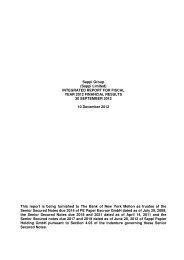2007 Annual Report - Sappi
2007 Annual Report - Sappi
2007 Annual Report - Sappi
You also want an ePaper? Increase the reach of your titles
YUMPU automatically turns print PDFs into web optimized ePapers that Google loves.
Notes to the group annual financial statements continued<br />
for the year ended September <strong>2007</strong><br />
2. Accounting policies continued<br />
The following methods and rates were used during the year<br />
to depreciate property, plant and equipment to estimated<br />
residual values:<br />
Land<br />
No depreciation<br />
Buildings straight line 40 years<br />
Plant straight line 5 to 20 years<br />
Vehicles straight line 5 to 10 years<br />
Furniture and equipment straight line 3 to 6 years<br />
Assets held under finance leases are depreciated over their<br />
expected useful lives or the term of the relevant lease, where<br />
shorter. The useful lives and residual values of property, plant and<br />
equipment are reviewed on an annual basis – and are revised<br />
when the current estimate is different from the existing estimate.<br />
The gain or loss arising on the disposal or scrapping of property,<br />
plant and equipment is recognised in profit or loss.<br />
2.3.15 Segment reporting<br />
The primary business segments are <strong>Sappi</strong> Fine Paper and<br />
<strong>Sappi</strong> Forest Products. On a secondary segment basis, significant<br />
geographic regions have been identified based on the location<br />
of the productive assets, being Southern Africa, Europe and<br />
North America.<br />
Assets, liabilities, revenues or expenses that are not directly<br />
attributable to a particular segment are allocated between<br />
segments where there is a reasonable basis for doing so. The<br />
group accounts for intersegment revenues and transfers as if<br />
the transactions were with third parties at current market prices.<br />
2.3.16 Share-based payments<br />
(i) Equity-settled share-based payment<br />
transactions with employees<br />
The services received in an equity-settled share-based payment<br />
transaction with employees are measured at the fair value of<br />
the equity instruments granted. The fair value of those equity<br />
instruments is measured at grant date.<br />
If the equity instruments granted vest immediately and an<br />
employee is not required to complete a specified period of<br />
service before becoming unconditionally entitled to those<br />
instruments, the services received are recognised in profit or<br />
loss for the period in full on grant date with a corresponding<br />
increase in equity.<br />
Where the equity instruments do not vest until the employee has<br />
completed a specified period of service, it is assumed that the<br />
services rendered by the employee, as consideration for those<br />
equity instruments, will be received in the future during the vesting<br />
period. These services are accounted for in profit or loss as they<br />
are rendered during the vesting period, with a corresponding<br />
increase in equity. Share-based payment expenses are adjusted<br />
for non-market-related performance conditions.<br />
(ii) Measurement of fair value of equity<br />
instruments granted<br />
The equity instruments granted by the group are measured at<br />
fair value at measurement date using modified binomial option<br />
pricing valuation models. The valuation technique is consistent<br />
with generally acceptable valuation methodologies for pricing<br />
financial instruments and incorporates all factors and<br />
assumptions that knowledgeable, willing market participants<br />
would consider in setting the price of the equity instruments.<br />
2.3.17 Shareholders’ equity<br />
(i) Share capital<br />
Share capital issued by the company is recorded as the<br />
proceeds received, net of direct issue costs.<br />
Ordinary and preference share capital is classified as equity, if<br />
the shares are non-redeemable by the shareholder and any<br />
dividends are discretionary.<br />
(ii) Treasury shares<br />
When share capital recognised as equity is repurchased by the<br />
company or other members of the group, the amount of the<br />
consideration paid, including directly attributable costs, is<br />
recognised as a change in equity. Shares repurchased by the<br />
issuing company are cancelled.<br />
Shares repurchased by group companies are classified as<br />
treasury shares and are held at cost. These shares are treated<br />
as a deduction from the issued and weighted average number<br />
of shares and the cost price of the shares is presented as a<br />
deduction from total equity. The par value of the shares is<br />
presented as a deduction from ordinary share capital and the<br />
remainder of the cost is presented as a deduction from ordinary<br />
share premium. Dividends received on treasury shares are<br />
eliminated on consolidation.<br />
(iii) Dividends<br />
Dividends are recognised as distributions within equity in the<br />
period in which they are payable to shareholders. Dividends for<br />
84<br />
sappi limited | 07 | annual report
















